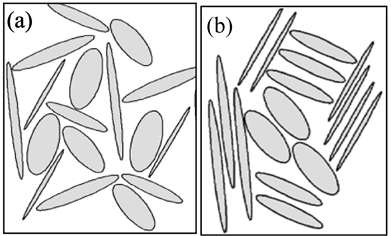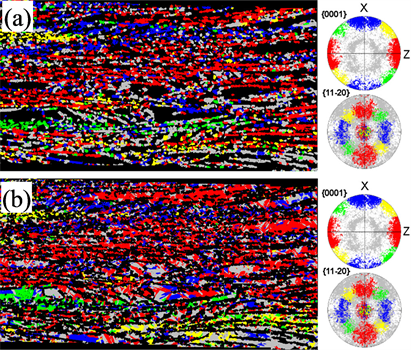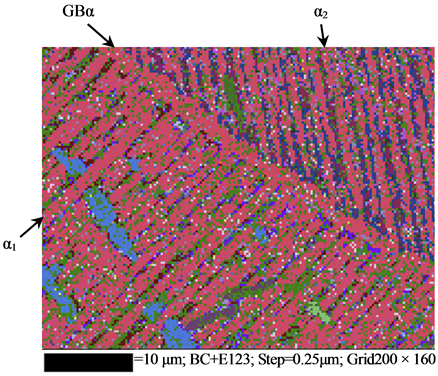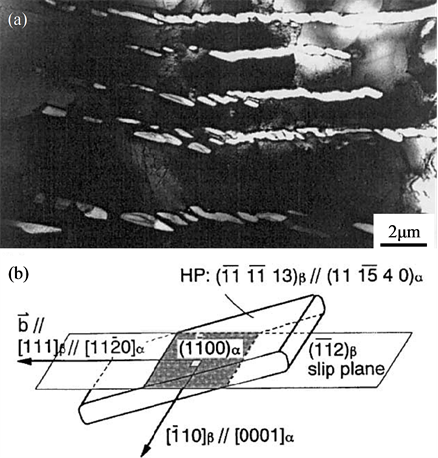Material Sciences
Vol.4 No.05(2014), Article
ID:14107,7
pages
DOI:10.12677/MS.2014.45028
Variant Selection of β→α Phase Transformation in Titanium Alloys
1Research Institute (R & D Center), Baosteel Group Cooperation, Shanghai
2Northwest Institute for Non-Ferrous Metal Research, Xi’an
3Xi’an University of Architecture and Technology, Xi’an
Email: *yiyang.imr@163.com
Copyright © 2014 by authors and Hans Publishers Inc.
This work is licensed under the Creative Commons Attribution International License (CC BY).
http://creativecommons.org/licenses/by/4.0/



Received: Jul. 4th, 2014; revised: Aug. 2nd, 2014; accepted: Aug. 15th, 2014
ABSTRACT
β→α transformation is the most essential phase transition in titanium alloys. The α phase formed in the β matrix is oriented according to the so-called Burgers orientation relationship, viz. (0001)α//{110}β and <11 0>α//<111>β. Because of the symmetry of the two crystals, 12 α variants can form in a β grain theoretically. Variant selection can take place in almost all kinds of titanium alloys and decline the strength, plasticity and fatigue resistance, which have been attended by the researchers gradually. To control the occurrence of variant selection will be one of the potential methods to improve the properties of titanium alloys. In this paper, by integrating our research work, the progress in research of variant selection of β→α phase transformation in titanium alloys is briefly reviewed from aspects of the substance and the reason of variant selection, and its influence on the mechanical properties. The problems at present study and the research directions in the future are also analyzed.
0>α//<111>β. Because of the symmetry of the two crystals, 12 α variants can form in a β grain theoretically. Variant selection can take place in almost all kinds of titanium alloys and decline the strength, plasticity and fatigue resistance, which have been attended by the researchers gradually. To control the occurrence of variant selection will be one of the potential methods to improve the properties of titanium alloys. In this paper, by integrating our research work, the progress in research of variant selection of β→α phase transformation in titanium alloys is briefly reviewed from aspects of the substance and the reason of variant selection, and its influence on the mechanical properties. The problems at present study and the research directions in the future are also analyzed.
Keywords:Titanium Alloy, Phase Transformation, Crystallography, Variant Selection, Review

钛合金β→α相变的变体选择
杨 义1*,卢亚锋2,葛 鹏2,冯 亮2,屈 磊2,3,周 伟2,黄爱军1
1宝钢集团中央研究院,上海
2西北有色金属研究院,西安
3西安建筑科技大学,西安
Email *yiyang.imr@163.com
收稿日期:2014年7月4日;修回日期:2014年8月2日;录用日期:2014年8月15日

摘 要
β→α转变是钛合金中最基本和最重要的一种相变,两相之间存在严格的Burgers取向关系,即(0001)α// {110}β和<11 0>α//<111>β,这种关系决定了在一个β晶粒内可能会出现12个α相变体。在各种类型的钛合金中,均会出现在一个β晶粒内只有少数几个取向的α相能够存在的现象,即发生变体选择,其对强度、塑性、疲劳等力学性能的负面影响逐步被关注,抑制其发生将是进一步提高钛合金性能的潜在方法之一。本文结合作者的研究工作,介绍了钛合金中β→α转变时发生变体选择的本质、成因以及对合金力学性能的影响等方面的研究现状,并分析了该研究方向目前存在的问题和今后的研究重点。
0>α//<111>β,这种关系决定了在一个β晶粒内可能会出现12个α相变体。在各种类型的钛合金中,均会出现在一个β晶粒内只有少数几个取向的α相能够存在的现象,即发生变体选择,其对强度、塑性、疲劳等力学性能的负面影响逐步被关注,抑制其发生将是进一步提高钛合金性能的潜在方法之一。本文结合作者的研究工作,介绍了钛合金中β→α转变时发生变体选择的本质、成因以及对合金力学性能的影响等方面的研究现状,并分析了该研究方向目前存在的问题和今后的研究重点。
关键词
钛合金,相变,晶体学,变体选择,综述

1. 引言
钛合金中存在多种类型的相变,β→α相变是其中最基本和最重要的一种,几乎所有钛合金自高温冷却或/和在时效的过程中均会发生。α/β两相之间存在严格的Burgers取向关系,即(0001)α//{110}β和<11 0>α//<111>β[1] 。由于晶体的对称性,这种关系决定了在一个β晶粒内可以形成12种晶体学取向的α相,即12个α相变体(见表1),这些α相之间存在132种相对取向关系和5种类型的α/α晶界[2] 。理想状态
0>α//<111>β[1] 。由于晶体的对称性,这种关系决定了在一个β晶粒内可以形成12种晶体学取向的α相,即12个α相变体(见表1),这些α相之间存在132种相对取向关系和5种类型的α/α晶界[2] 。理想状态
Table 1. Twelve equivalent variants of the Burgers orientation relationship relating the β matrix to the α product phase [2]
表1. 与β相具有Burgers取向关系的12个等价的α相变体[2]
下,12个晶体学取向的α相会同几率形成,此时称为无变体选择。然而,在实际材料中,β→α相变时α的12个变体通常不会同时和同机率出现,经常会出现只有少数取向的α相能够形成的现象,此时称为发生了变体选择[3] 。钛合金的力学性能不只与α相的空间形态分布(表现为不同类型的显微组织和相尺寸)和宏观晶体学分布(表现为织构的强弱)有关,还受到α相变体选择的影响,α相变体选择对强度、塑性、疲劳等力学性能的负面影响逐步被关注[4] -[10] ,抑制其发生将是进一步提高钛合金性能的潜在方法之一。与对钛合金显微组织、宏观织构和力学性能的研究相比,对β→α相变时变体选择的研究要少得多,主要原因可能是适用于变体选择研究的最佳手段是电子背散射衍射技术(EBSD),而该技术在近十几年才得到迅猛的发展和较为广泛的应用;另外,变体选择对力学性能的影响不如显微组织类型和宏观织构的影响强烈,而且不易被检测到,导致其对力学性能的影响可能没有被足够的认识并受到普遍的重视。本文结合作者的研究工作,从变体选择的本质、成因以及对合金力学性能的影响等几个方面,介绍了钛合金中β→α转变时变体选择研究的现状,并分析了该研究方向目前存在的问题和今后的研究重点。
2. 变体选择的本质
在宏观上无序的钛合金,假定其包含最基本的α和β两相,当选取的空间范围减小到一定尺度时,总会存在包含单一取向α相的区域(一个原始母相β晶粒内的一部分),宏观材料便是无数个这种区域的有机集合体。理想状态下,在这一微小空间的原母相内,所有12个α相变体具有相同的形成几率,形成何种取向的α相是随机的。从热力学角度来说,形成其中任意一个α相变体所造成的系统能量变化是完全相同的。当把范围扩大到一个β晶粒内,那么,最终形成的12个α相变体所占有的体积分数是相同的,即无变体选择(见图1(a)[11] )。然而,在实际材料中,由于各种复杂因素的存在,这一微小空间的原母相在发生β→α相变时受该处周围环境的影响,会造成某一个α相变体更容易形成。从热力学角度来说,形成这一α相变体所造成的系统能量降低会更多,即发生了变体选择(见图1(b)[11] )。它会造成在一个β晶粒内仅有少数几个α相变体能够形成。
因此,变体选择的本质原因是其发生时系统的能量降低更多,从表象上来说,它实际上是α相的局部择优取向生长。
3. 变体选择的成因及对性能的影响
近年来,通过实验和模拟相结合对β→α转变时的变体选择开展了一些研究,结果表明,其在各种类型的钛合金中均会发生,造成变体选择的主要因素有初生α相[12] -[15] 、特殊的β晶界[3] [16] -[18] 和β相中的位错[7] [8] 等。

Figure 1. Two-dimensional view of variant distribution. (a) No variant selection; (b) Variant selection. (one variant per shape) [11]
图1. 变体分布二维示意图。 (a) 无变体选择; (b) 有变体选择(每个形状代表一个变体) [11]
Germain和Humbert等人[12] -[15] 在研究α + β相区变形和热处理的IMI 834近α型钛合金时发现,合金中存在一些几个平方毫米范围的等轴初生α相的(0001)α面微织构区域,被称为“宏区”,区域内80%的次生α片层的(0001)α面与初生α相的(0001)α面平行(见图2[14] )。作者等人对魏氏组织的BT18Y近α型钛合金在α + β相区的固溶处理进行了初步研究,实验结果表明,空冷时次生α片层在初生α片的端部形核,并保持与初生α片相同的晶体学取向生长[19] (见图3,未发表)。已经有多名研究者报道,疲劳裂纹主要纹萌生于(0001)α面上,(0001)α面的局部微织构使得单个α相内萌生的微裂纹不需要改变方向就能够在微织构区域内扩展,很容易就能合并成较大尺寸的裂纹,从而降低材料的疲劳性能[4] -[6] [9]

Figure 2. Macrozones in IMI834 near α titanium alloy. EBSD map of the primary α grains (αp) (a) and the secondary α colonies (αs) (b) (the color key is given by the PFs at the right side) [14]
图2. IMI834近α钛合金中的“宏区”。初生α晶粒(αp) (a)和次生α片束(αs) (b)的EBSD取向图 [14]

Figure 3. Secondary α lamellae (αs) nucleating and growing from the end of primary α lamellae (αp), keeping the crystallographic orientation of αp. (a) SEM image; and pole figures of αp (b) and αs (c)
图3. BT18Y钛合金中次生α片层(αs)在初生α片层(αp)的端部形核生长并保持与αp相同的晶体学取向。(a) SEM图; (b) 初生α (αp)极图; (c) 次生α (αs)极图
[10] 。这种变体选择的发生是由于初生α相为次生α相提供了形核位置,降低了形核的能量。改变和增加次生α片的形核位置以减弱初生α相的影响将是减弱此类变体选择的研究重点。作者等人对BT18Y合金的初步研究结果表明,通过控制冷却速度结合适当的后继热处理可以有效增加次生α片的变体数量,更全面和深入的研究正在继续开展。
Furuhara等人[20] 和Miyano等人[21] 的研究表明,在β晶界上析出的晶界α相与其中一侧的β相具有共格的取向关系,而与另一侧的β相没有取向关系,显然,前者的α/β界面能较低而后者较高。Bhattacharyya等人[16] [17] 和Stanford与Bate[18] 分别研究了α + β型的Ti-6246和Ti-6Al-4V合金在β相区固溶后冷却过程中的β→α相变,进一步分析了相邻两个β晶粒的晶体学取向差对变体选择的作用。结果表明,当两个β晶粒有一个{110}β面平行时,析出的晶界α相的(0001)α面将平行于该共同的{110}β面,晶界α相两侧生长的α片尽管在形貌上可能存在很大的角度差,但是它们的(0001)α面平行。特别地,对于以<110>β轴旋转10.5˚和以<111>β轴旋转60˚的相邻两个β晶粒,晶界α相与两侧的β相均具有共格的取向关系,并且与两侧的晶内α片甚至可以具有相同的晶体学取向(见图4[16] )。这意味着,发生变体选择的α片束团尽管在形貌上与相邻的α片束团具有不同的方向,但是在晶体学上却是一个整体,即α片束团的实际晶体学尺寸增加了。这使得在变形时位错的有效滑移程增大,合金的强度和疲劳性能会因此而降低[22] 。造成晶界α相发生变体选择的原因是形成这种取向的晶界α相会使得两侧的α/β界面能总和最低,而在晶界α相形成后,其相对于两侧后形成的晶内α片为初生α相,从而使得两侧从该处形核的晶内α片也发生变体选择。
控制该类型变体选择的发生需要消除有一个{110}β面平行的两个相邻β晶粒,而弄清该类β/β晶粒偶的来源问题是研究的关键。传统观点认为这种特征的β/β晶粒偶来源于高温下塑性变形和再结晶的β相织构[12] ,最近有观点则认为其来源于具有特殊取向关系的两个相邻α晶粒加热时α→β转变的变体选择[23] ,目前仍缺乏直接证据来充分支持这两种观点。至今为止,前一种观点仍占主导地位,认为要减弱该类型α相的变体选择,应该采用能够减小或避免{110}β织构的热机械处理。近年出现的带原位加热功

Figure 4. OM image of the Widmanstätten structure, showing α lamellae on two sides keeping the same crystallographic orientation with grain boundary α phase, although the directions of α being different to each other. Similar orientations displaying in similar colors [16]
图4. 魏氏组织的OM图,表明晶界α相(GBα)与两侧的α片尽管生长方向差异很大,但是具有相同的晶体学取向。相近的取向表现为相近的颜色 [16]

Figure 5. (a) α precipitates formed in the slip band; (b) Schematic illustration showing the variant selection of α in the slip band [7]
图5. (a) α相在滑移带中析出;(b) α相在滑移带中发生变体选择的示意图 [7]
能的电子背散射衍射技术使得通过实验精确研究α→β相变晶体学成为了可能[24] ,为开展对后一种观点的实验研究提供了有力的技术支持,但是目前仍未见有相关报道,作者等人目前正在开展相关研究。
Furuhara等人[7] [8] 对β单相区固溶后的β型Ti-15V-3Cr-3Sn-3Al钛合金进行冷轧后时效,发现在滑移带中的位错上析出的α相的(1 00)α面平行于{112}β滑移面,密排方向[11
00)α面平行于{112}β滑移面,密排方向[11 0]α平行于位错的柏氏矢量<111>β方向(见图5[7] )。由于在一个{112}β滑移面上仅有一个<111>β柏氏矢量,滑移带中析出的α相将具有相同的取向,这种变体选择的发生是因为位错应变场可以有效吸收相变应变。此时,尽管细小α相的强化会使得合金具有高强度,但是塑性和韧性却很差。由于时效时α相优先在滑移带中析出,而且α相的取向与位错的晶体学特征密切相关,因此改变缺陷分布是该类变体选择的研究重点。Furuhara等人[7] [8] 已经开展了相关研究,他们对上述合金通过在轻微冷轧和时效之间插入短时的β相区回复处理,使得滑移带中平行的位错演化成β亚晶界,时效时在亚晶界上析出的α相取向不再受位错柏氏矢量的限制,α相变体明显增多,改善了钛合金的强/塑性、强/韧性平衡,为该类型钛合金综合性能的优化提供了一种新的思路。
0]α平行于位错的柏氏矢量<111>β方向(见图5[7] )。由于在一个{112}β滑移面上仅有一个<111>β柏氏矢量,滑移带中析出的α相将具有相同的取向,这种变体选择的发生是因为位错应变场可以有效吸收相变应变。此时,尽管细小α相的强化会使得合金具有高强度,但是塑性和韧性却很差。由于时效时α相优先在滑移带中析出,而且α相的取向与位错的晶体学特征密切相关,因此改变缺陷分布是该类变体选择的研究重点。Furuhara等人[7] [8] 已经开展了相关研究,他们对上述合金通过在轻微冷轧和时效之间插入短时的β相区回复处理,使得滑移带中平行的位错演化成β亚晶界,时效时在亚晶界上析出的α相取向不再受位错柏氏矢量的限制,α相变体明显增多,改善了钛合金的强/塑性、强/韧性平衡,为该类型钛合金综合性能的优化提供了一种新的思路。
4. 结语
近年来,关于钛合金中β→α转变时变体选择的研究逐年增多,并获得了一些有意义的结果,但是与对钛合金显微组织、宏观织构和力学性能的研究相比,对β→α相变时变体选择的研究要少得多。从变体选择对性能的影响来看,减弱或抑制其发生将是进一步提高钛合金性能的潜在方法之一。但是,从目前的报道来看,对β→α相变的变体选择的控制缺乏有效的手段,仍然无法从根本上消除变体选择的发生。目前关于钛合金中β→α相变时变体选择的研究绝大多数均是由美国、英国、法国、日本、加拿大等发达国家的研究人员完成。近年来,我国在钛合金基础研究方面的投入不断加强,但是与发达国家相比仍有不小的差距。我们有必要深入开展相关研究,这不光对于进一步促进钛合金相变晶体学的基础研究发展具有学术意义,对于进一步提高钛合金的性能也具有应用价值。
基金项目
国家自然科学基金资助项目(51001088)。
参考文献 (References)
- [1] Burgers, W.G. (1934) On the process of transition of the cubic body centered modification into the hexagonal close packed modification of zirconium. Physica, 1, 561-586.
- [2] Wang, S.C., Aindow, M. and Starink, M.J. (2003) Effect of self-accommodation on α-α boundary populations in pure titanium. Acta Materialia, 51, 2485-2503.
- [3] Bohemen, S.M.C.V., Kamp, A., Petrov, R.H., Kestens, L.A.I. and Sietsma, J. (2008) Nucleation and variant selection of secondary α plates in a β Ti alloy. Acta Materialia, 56, 5907-5914.
- [4] Bache, M.R., Cope, M., Davies, H.M., Evans, W.J. and Harrison, G. (1997) Dwell sensitive fatigue in a near alpha titanium alloy at ambient temperature. International Journal of Fatigue, 19, 83-88.
- [5] Biavant, K.L., Pommier, S. and Prioul, C. (2002) Local texture and fatigue crack initiation in a Ti-6Al-4V titanium alloy. Fatigue and Fracture of Engineering Materials and Structures, 25, 527-545.
- [6] Szczepanski, C.J., Jha, S.K., Larsen, J.M. and Jones, J.W. (2007) The role of microstructure on fatigue lifetime variability in an α+β Ti-alloy. In: Allison, J.E., Jones, J.W., Larsen, J.M. and Ritchie, R.O., Eds., Fourth International Conference on Very High Cycle Fatigue, Wiley, Ann Arbor.
- [7] Furuhara, T. and Maki, T. (2001) Variant selection in heterogeneous nucleation on defects in diffusional phase transformation and precipitation. Materials Science and Engineering A, 312, 145-154.
- [8] Furuhara, T., Maki, T. and Makino, T. (2001) Microstructure control by thermomechanical processing in β-Ti-15-3 alloy. Journal of Materials Processing Technology, 117, 318-323.
- [9] Bache, M.R. and Evans, W.J. (2001) Impact of texture on mechanical properties in an advanced titanium alloy. Materials Science and Engineering A, 319-321, 409-414.
- [10] Evans, W.J., Jones, J.P. and Whittaker, M.T. (2005) Texture effects under tension and torsion loading conditions in titanium alloys. International Journal of Fatigue, 27, 1244-1250.
- [11] Gourgues-Lorenzon, A.F. (2007) Application of electron backscatter diffraction to the study of phase transformations. International Materials Reviews, 52, 65-128.
- [12] Germain, L., Gey, N., Humbert, M., Bocher, P. and Jahazi, M. (2005) Analysis of sharp microtexture heterogeneities in a bimodal IMI 834 billet. Acta Materialia, 53, 3535-3543.
- [13] Germain, L., Gey, N., Humbert, M., Hazotte, A., Bocher, P. and Jahazi, M. (2005) An automated method to analyze separately the microtextures of primary αP grains and the secondary αS inherited colonies in bimodal titanium alloys. Materials Characterization, 54, 216-222.
- [14] Germain, L., Gey, N., Humbert, M., Vo, P., Jahazi, M. and Bocher, P. (2008) Texture heterogeneities induced by subtransus processing of near α titanium alloys. Acta Materialia, 56, 4298-4308.
- [15] Humbert, M., Germain, L., Gey, N., Bocher, P. and Jahazi, M. (2006) Study of the variant selection in sharp textured regions of bimodal IMI 834 billet. Materials Science and Engineering: A, 430, 157-164.
- [16] Bhattacharyya, D., Viswanathan, G.B. and Fraser, H.L. (2007) Crystallographic and morphological relationships between β phase and the Widmanstätten and allotriomorphic α phase at special β grain boundaries in an α/β titanium alloy. Acta Materialia, 55, 6765-6778.
- [17] Bhattacharyya, D., Viswanathan, G.B., Denkenberger, R., Furrer, D. and Fraser, H.L. (2003) The role of crystallographic and geometrical relationships between α and β phases in an α/β titanium alloy. Acta Materialia, 51, 4679-4691.
- [18] Stanford, N. and Bate, P.S. (2004) Crystallographic variant selection in Ti-6Al-4V. Acta Materialia, 52, 5215-5224.
- [19] 杨义, 徐锋, 黄爱军, 李阁平 (2005) 全片层BT18Y钛合金在α+β相区固溶时的显微组织演化. 金属学报, 7, 713-720.
- [20] Furuhara, T., Takagi, S., Watanabe, H. and Maki, T. (1996) Crystallography of grain boundary α precipitates in a β titanium alloy. Metallurgical and Materials Transactions A, 27, 1635-1646.
- [21] Miyano, N., Fujiwara, H., Ameyama, K. and Weatherly, G.C. (2002) Preferred orientation relationship of intraand inter-granular precipitates in titanium alloys. Materials Science and Engineering: A, 333, 85-91.
- [22] Wilson, R.J., Randle, V. and Evans, W.J. (1997) The influence of the Burgers relation on crack propagation in a near α-titanium alloy. Philosophical Magazine A, 76, 471-480.
- [23] Cayron, C. (2008) Importance of the α→β transformation in the variant selection mechanisms of thermomechanically processed titanium alloys. Scripta Materialia, 59, 570-573.

NOTES
*通讯作者。
